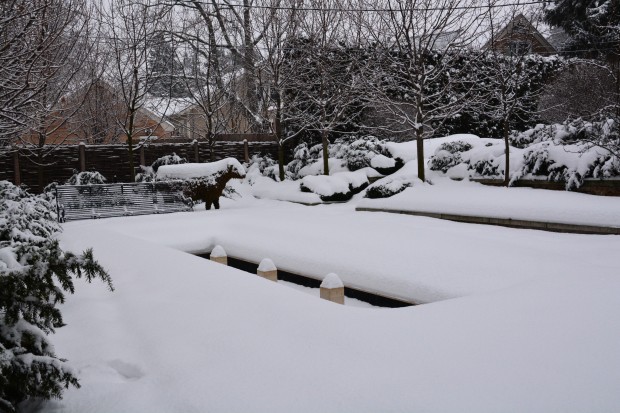 My friend Michael wrote me yesterday that the National Weather Service should have issued a “boxwood obliteration warning” along with all of their other communiques on our endless string of winter storms. I perfectly understand his irritation. We have had storm after storm, layered between bouts of very cold temperatures. This means the snow is piling up. The piles along my sidewalks are easily 6′ tall. Thick layers of snow are extremely heavy. My boxwood hedges are very densely twiggy, and seemed to be handling the weight with relative ease. But some select spots of those boxwood hedges are beginning to look alarmingly splayed open from the weight of the snow. Am I worrying-oh yes. Other shrubby plants are beginning to get that smothered and half strangled look. This observation having been made, I have always been a member of the do not touch group. Am I recommending that you do not touch a shrub going down from a load of snow? No. How you handle your garden is your business. What is to follow is a discussion of my experience. Do with that what you will.
My friend Michael wrote me yesterday that the National Weather Service should have issued a “boxwood obliteration warning” along with all of their other communiques on our endless string of winter storms. I perfectly understand his irritation. We have had storm after storm, layered between bouts of very cold temperatures. This means the snow is piling up. The piles along my sidewalks are easily 6′ tall. Thick layers of snow are extremely heavy. My boxwood hedges are very densely twiggy, and seemed to be handling the weight with relative ease. But some select spots of those boxwood hedges are beginning to look alarmingly splayed open from the weight of the snow. Am I worrying-oh yes. Other shrubby plants are beginning to get that smothered and half strangled look. This observation having been made, I have always been a member of the do not touch group. Am I recommending that you do not touch a shrub going down from a load of snow? No. How you handle your garden is your business. What is to follow is a discussion of my experience. Do with that what you will.
 My PJM rhododendrons have broad leaves, arranged in tufts atop slender branches. Heavy wet snow in 28 degree weather that sticks to those tufts usually slides off. But if the temps take a sudden dive, those wet greasy snowballs can harden and stick. A weighty iceball on the end of a long slender branch can prove very destructive. Every gardener in a northerly climate has seen damage to trees and shrubs from ice. I have a substantial dogwood branch that broke close to the main trunk last spring. The weight of the ice on the branches was enough to snap the branch, almost through. As for these PJMs, warmer weather will tell the tale. I feel quite sure if I were to try to dislodge this caked icy snow, I would damage the plants.
My PJM rhododendrons have broad leaves, arranged in tufts atop slender branches. Heavy wet snow in 28 degree weather that sticks to those tufts usually slides off. But if the temps take a sudden dive, those wet greasy snowballs can harden and stick. A weighty iceball on the end of a long slender branch can prove very destructive. Every gardener in a northerly climate has seen damage to trees and shrubs from ice. I have a substantial dogwood branch that broke close to the main trunk last spring. The weight of the ice on the branches was enough to snap the branch, almost through. As for these PJMs, warmer weather will tell the tale. I feel quite sure if I were to try to dislodge this caked icy snow, I would damage the plants.
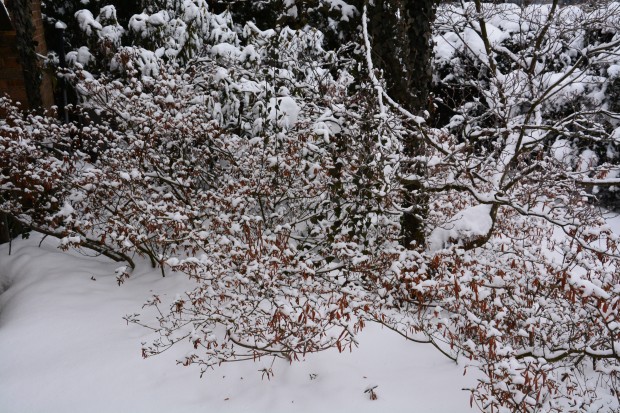 When snow buries both evergreen and deciduous shrubs, I have no worries. Snow is an insulator, a winter packing material of sorts. Most snow is light, and infills all of the spaces between the branches. But when heavy snow collects, freezes hard, and glues itself to the ends of branches that are not so hefty, an alarm goes off. Shall I brush the heavy snow off of the tips of my shrubs, or leave that snow be? Plants are tough, but maybe not tough enough in their already stressed circumstances to withstand a broom.
When snow buries both evergreen and deciduous shrubs, I have no worries. Snow is an insulator, a winter packing material of sorts. Most snow is light, and infills all of the spaces between the branches. But when heavy snow collects, freezes hard, and glues itself to the ends of branches that are not so hefty, an alarm goes off. Shall I brush the heavy snow off of the tips of my shrubs, or leave that snow be? Plants are tough, but maybe not tough enough in their already stressed circumstances to withstand a broom.
I do not plant even arborvitaes when the weather is right around freezing. The needles will surely brown wherever I touch them. I do not brush the snow off of any plant-especially when the temperature is really cold. I have always thought that my efforts to clear snow from my plants may do more harm than good. I am more inclined to back off, and wring my hands in private. Plants have an incredible will to live. I have a substantial broken dogwood branch that has been hanging on by a one inch wide piece of bark for better than a year. It is loaded with buds for spring. No matter how terrible the winter weather is, my inclination is to not intervene.
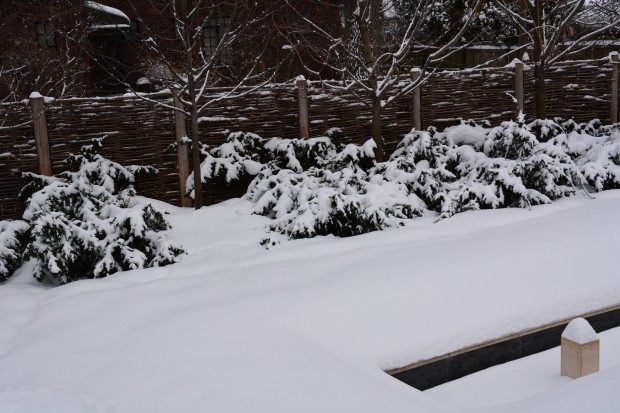 Snow cover which is frozen through and through is a tough coating to remove. Just tonight I was chopping ice on my deck with a shovel. I do not want to slip and fall-nor do I want my corgis to slip and strain a muscle. I am not a fan of ice anywhere in the travelled landscape, except as a last resort. Chopping the ice on a deck is a vastly different issue that brooming wet frozen snow from my yews. The densiformis yews pictured above have arms bent to the ground. I have no idea if those branches are bent to the breaking point. Branches are subject to all manner of insults from weather. Wind, sun scald-the scraping from my staking, the scale-branches endure assault year round. Should I broom the snow off of them? Could I damage the branches even more, if I interfere?
Snow cover which is frozen through and through is a tough coating to remove. Just tonight I was chopping ice on my deck with a shovel. I do not want to slip and fall-nor do I want my corgis to slip and strain a muscle. I am not a fan of ice anywhere in the travelled landscape, except as a last resort. Chopping the ice on a deck is a vastly different issue that brooming wet frozen snow from my yews. The densiformis yews pictured above have arms bent to the ground. I have no idea if those branches are bent to the breaking point. Branches are subject to all manner of insults from weather. Wind, sun scald-the scraping from my staking, the scale-branches endure assault year round. Should I broom the snow off of them? Could I damage the branches even more, if I interfere?
 Most of my boxwoods are buried in snow. Once a too heavy snow load falls to one side, and splits open a shrub, I am alarmed. Snow can be heavy enough to crack branches open. There can be fresh hell to pay in the spring. Cracked branches are an invitation to disease. A beloved boxwood hedge with a big dead section is enough to make any gardener weep. My advice? Do not intervene in the natural order of events, unless the need for intervention wakes you up in the middle of the night. If you must intervene, use a long bamboo pole-gently. Wait until the weather is close to, or above freezing. A branch frozen through and through is brittle. If you must remove excessive snow, tickle it off.
Most of my boxwoods are buried in snow. Once a too heavy snow load falls to one side, and splits open a shrub, I am alarmed. Snow can be heavy enough to crack branches open. There can be fresh hell to pay in the spring. Cracked branches are an invitation to disease. A beloved boxwood hedge with a big dead section is enough to make any gardener weep. My advice? Do not intervene in the natural order of events, unless the need for intervention wakes you up in the middle of the night. If you must intervene, use a long bamboo pole-gently. Wait until the weather is close to, or above freezing. A branch frozen through and through is brittle. If you must remove excessive snow, tickle it off.
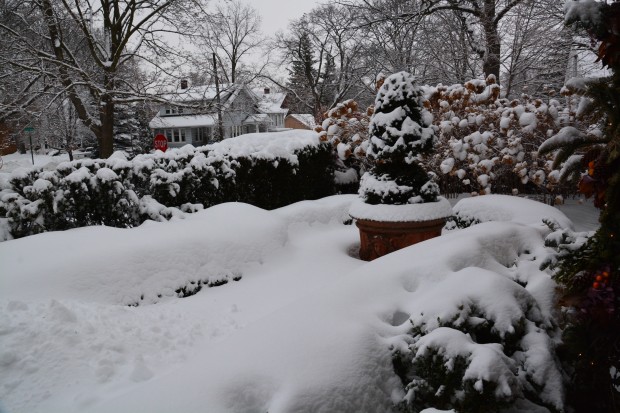 There are those that favor removing snow from shrubs. There are those that favor letting nature take its course. For the moment, I am standing pat. A good bit of my reason-I cannot really reach them anymore.
There are those that favor removing snow from shrubs. There are those that favor letting nature take its course. For the moment, I am standing pat. A good bit of my reason-I cannot really reach them anymore.
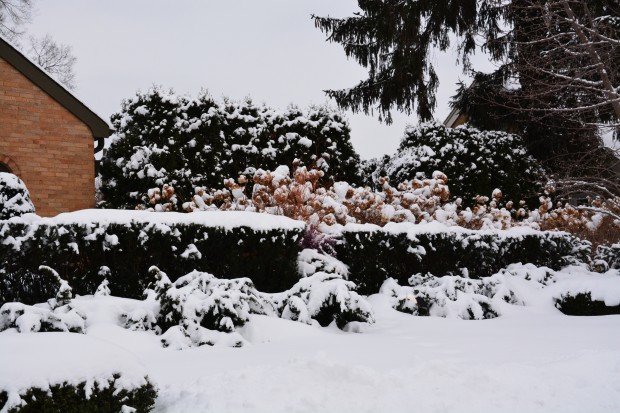 No matter the work that I do in my garden, I feel sure that each and every plant comes equipped with all the survival gear it needs. Nature has never needed much from me. I am believing these densiformis yews will spring back, once we have a decent melt. But there are those moments in a garden that warrant intervention. The trick is to judge the right time and circumstance.
No matter the work that I do in my garden, I feel sure that each and every plant comes equipped with all the survival gear it needs. Nature has never needed much from me. I am believing these densiformis yews will spring back, once we have a decent melt. But there are those moments in a garden that warrant intervention. The trick is to judge the right time and circumstance.
 Though I am not entertaining, planting, weeding, or watering right now, my garden is on my mind. Like the corgis, my garden cannot tell me where it hurts. I observe, and make my best call.
Though I am not entertaining, planting, weeding, or watering right now, my garden is on my mind. Like the corgis, my garden cannot tell me where it hurts. I observe, and make my best call.
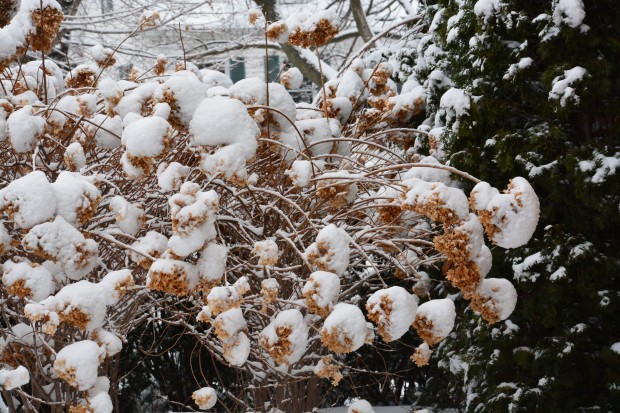 My winter weary shrubs – it is a worry. And we have more snow on the way.
My winter weary shrubs – it is a worry. And we have more snow on the way.

Should you feel the need to ‘tickle’ with your bamboo pole I fear you would be busy until Spring trying to remove remove the horrendous amount of snow you have in your garden. As you say… perhaps it’s best to leave it be and let nature take it’s course. I am trusting that Mother Nature will be kind and allow your wonderful boxwoods to survive. I’ll keep tuned in to see how things go. Good luck from a rain soaked and blustery UK. x
We decided to tickle our goldenthread cypress and dwarf mugo pine early in the season and periodically afterwards when they looked stressed. I just didn’t realize I was rough-housing a little too much the first time and might have lost a bough here or there. Ouch!
Dear Julie, plants are pretty forgiving-they will spring back from your “pruning”! Deborah
If it is any consolation, three years ago, under two+ feet of show cover, aged 3 foot yew hedges (taxus baccata) lining the drive into our neighborhood, were virtually flattened and terribly splayed. They remained this way for the better part of a month and a half. Being one-half of our Landscape Committee, we made the decision to wait it out, after reading that yews tend to “remember” their inherent shape and will come back when they re-energize in the Spring. It took several months post Spring for them to revive but they were almost perfect when it was time to shear in late summer. I agree that Mother Nature equips us all with survival genes, old age nothwithstanding.
Dear Judith, your letter is a consolation. The only severe damage I have ever had from snow and ice affected my arborvitae. Some 14 feet tall, they went right down to the ground. Now they have a series of stakes and cloth tree tie intended to help them weather a snowy winter better. I feel fairly confident that my yews will rebound, as they are a draping shape to begin with. Deborah
Deborah,
This heavy snow on my boxwoods has been on my mind all winter.
Our plower, who also shovels the front walk, throws additional snow on top
of the boxwoods lining both sides. The piles have frozen, thawed, and
refrozen. These boxwoods needed a good hard prune anyway, so I guess I’ll
wait till spring.
A bigger concern is the snow dumped on our deciduous azaleas; they most
likely will not recover and I’m afraid it’s too late, even if we could remove
the snow.
I’m so glad to hear your thoughts since this has been in the back of my mind
all
winter.
Dear Starr, I have never had any problem with my azaleas-but there is always a first time. I do think touching them now would cause great harm. What is the most alarming is how many more opportunities we have for snow before this winter ends. Deborah
Thankfully, my columnar Irish yews (taxus baccata fastiagata) were tied up with twine in December. I shudder to think what would have happened to their branches with all this snowfall. For the boxwoods, I used to be more than a little bit skeptical reading Martha Stewart’s blog, in which she explained how every year her expansive collection of boxwoods was covered in custom made bamboo and jute ‘tents’, to protect them against heavy snow. Was this total overkill perhaps? It looks like she was prescient … and obviously she has the large staff who can execute this work.
Dear Antoine, Martha Stewart has had those tents for quite some time. It could be she gets snowfall every year that would damage her plants. In that case, she is just taking extra good care of them. We do not usually get enough snow to warrant that kind of protection. Your Irish yews would have taken this snow really hard-I too am glad you have them tied up. Deborah Deborah
I was going to say the same thing! I read her blog every day and often have rolled my eyes at the burlap tents. She is vindicated. I should have known she’s never wrong! I am a fusser. I go out and gently broom off my shrubs often. I think it’s because I’m bored and am ready to garden.
Dear Stephen, the fact that you never let the snow build up very much is good. I don’t dare come to the party this late. Burlapping boxwood to protect against snow load would require a really strong – maybe even rigid – structure. It could be her primary aim is to protect the boxwood from dessicating winter winds. Deborah
Well, the main reason I have yews and boxwoods is that winters in Michigan are just about 4-5 months long. Therefore, I like to have interesting shapes and structures in my garden, especially during the winter. As Jacques Wirtz (and possibly other people) said: if you don’t have a garden in the winter, you have no garden at all. Who wants to look at burlap bags? It always looked like total overkill to me – until this year that is!
Dear Antoine, how right you are. Who wants to look at burlap? I hate that. Nor do I see burlap as protection against snow load. It is not that strong. I see that it helps with winter burn-from wind, sun, and salt. Deborah
5-7 inches tonight. Too much. I did intervene and remove all the snow on our boxwood hedge. They plants are over six feet tall and had almost two feet of snow shelved on top. Then the wet snow started falling….that is when I become afraid. It was warm out so I took the risk and only managed to break off one small twig. The snow has already started to pile up again. Did I mention that we are getting 5-7 inches more tonight?!
Dear Michael, I think I would have gotten rid of that too. Boxwood that tall could be damaged. Good Lord, yes you did mention 5″ to 7″ tonight. Deborah
I have been at the windows almost constantly, watching the snow but I am more afraid of intervention than snow and ice.
My biggest concern is the rabbits. I planted 20-something young trees and placed a protective sleeve at the base but the snow rose above it, allowing the bunnies free reign of the remainder.
I feel like a mother waiting for her child to come home from a late night.
xo
Andie
Dear Andie, your feelings are dead on. I’ll keep my fingers crossed for you and your fledgling trees. Deborah
Deborah, have you ever been to Big Rock in Birmingham in the winter? They have these fabulous covers on their boxwoods that are green with supports through them. They look like tents. I thought it was overkill but now I am thinking they are smarter than I am because I have no coverage.
Dear Diane, as soon as the roads clear from our latest snow, I am going to go look at Big Rock. If you have snow coverage, then you do have protection from extreme cold. Thanks, Deborah
I don’t know what’s worse, damage from snow, freezing and refreezing, or the deer. Such beautiful creatures but so much havoc when they are so hungry.
Dear Ann, I can imagine that heavy snowfall makes it really hard for the deer to find something to eat. There are no deer in my city neighborhood, and I am glad not to have to add that worry to my list. If I had to choose, I would leave all of the snow cover and take my chances. Deer are so incredibly destructive to garden plants. Deborah
Hi Deborah,
I am in the interference camp. I have some of those little arborvitae that stay in a ball shape. They splayed…and I shook the snow off of them. I also shook a little snow off of some new pine trees and my upright arbs. I know the snow is there to protect them, but I don’t shake it all off. Just enough to keep from straining them or ruining the shape.
I have some junipers that are upright, and they actually look nicer with the messed up branches. A bit wider and more wild…but it fits in with my garden.
Schmoo, you sound like a good and thoughtful gardener. Thanks for writing, Deborah